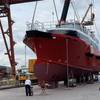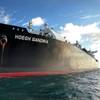Shipbuilding has always been close to his heart, but Vijay Kumar’s greatest desire is to see his country, India, exploit the benefits of shipbuilding for the greater good of India’s economy as a whole. To date, the shipbuilding business in India has come with more promise than production, with its market share at a mere one percent of global shipbuilding activity, Kumar, Managing Director of Bharati Shipyard Ltd., is determined to help grow the shipbuilding industry not just for the good of his company, but for the good of the country as a whole. He envisions, with government support, a dynamic growth in India’s shipbuilding market, projecting its output to soar to a global market share of between 5 to 7.5 percent in the next 10 years.
“From today’s order book position we can grow even 100 times,” said Kumar in a recent interview with Maritime Reporter & Engineering News. “We will be in a position to compete with China, Korea, Japan and Vietnam. This industry is labor intensive and has the highest investment multiplier. The reason why shipbuilding flourished in all of the so-called “low wage” countries such as Japan in the 60s and 70s; Korea in the 70s and 80s; and China from 80s to the turn of the century, is that they had governmental support for generating employment and creating a lot of down-stream industries.”
“Downstream industry investment would be around $40 billion by which the government would net $4 billion each year over and above what it gets today,” Kumar said. “It is a win-win situation for the government too. Within two or three years, shipbuilders can help generate 10 million additional jobs only if governmental support is made available to the industry.”
A Career Devoted to Shipbuilding
Kumar’s career has been devoted to shipbuilding, as he graduated as a Naval Architect from the Indian Institute of Technology (IIT) Kharagpur, in West Bengal. He served with Mazagaon Docks for seven years and in 1973 established Bharati Shipyard. Beginning as a partnership company, it was soon converted into a private limited company, and in 2004 the company went public, making it the first Indian shipyard to do so. The IPO was over-subscribed 78 times, which was a record on the Bombay Stock Exchange until it was only recently been broken.
What had been a two-shipyard company - one each at Ratnagiri and Ghodbunder - both on the West coast of India, Bharati Shipyard moved onto a higher growth trajectory on adopting a major expansion strategy. In 2004 it added four more shipyards, one at Calcutta, another at Goa and two Greenfield shipyards one at Mangalore and the other at Dhabol. The Dhabol shipyard is the largest yard spread over 300 acres with Mangalore shipyard being a close second in size.
“Dhabol is designed by First Marine International of the UK,” said Kumar. “The yard has a capacity to build among other vessels: Jack-up Drill Rigs, Offshore Structures, and ships of up to 100,000 DWT. The yard is now being geared to achieve self-sufficiency, with facilities for shipbuilding incorporating the most modern machinery and equipment. Presently, in Dhabol we are building a very sophisticated jack up drilling rig cantilever for the first time in the country, and it will be ready by the middle next year. This is about a $200 million project for Great Offshore. The rig will be able to drill up to 30,000 feet even where water depths exceed 350 ft.”
Building a Shipbuilding & Repair Stronghold
Kumar explains that each shipyard is designed to build different types of vessels. For example, the Ratnagiri and the Ghodbunder shipyards are meant for building sophisticated offshore vessels, dredgers, and similar vessels. The Calcutta and Goa shipyards are suited to build cargo vessels of 130 to 150 m, whereas the Mangalore shipyard builds vessels up to 175 to 200 m and the Dhabol yard manufactures vessels of 225 to 250 m long.
In April 2007 Bharati Shipyard Limited, acquired all the shipyard machinery and
Equipment of Swan Hunter (Typeside) Shipyard Ltd. Through this acquisition it acquired fully automated panel lines, quayside traveling gantry cranes of capacity up to 180T, 30 overhead traveling cranes of capacity up to 60T, Plate bending rolls of 2000 ton capacity, bending presses, robotic profiling machines, and CNC plasma burning equipment, to name the major additions.
“We acquired Swan Hunter, the naval ship yard in U.K. which had to close down because of high labor costs, since we could utilize the machinery and equipment to boost our production,” said Kumar. “Last year we also acquired Techma Shipyard which has three construction sites, one each at Chennai, Cochin and Malpe. As a result we now have nine shipyards both on the East coast and West coast of India placing us in a strong position to offer ship repair services and an ‘immediate response’ facility especially for Naval and Coast Guard vessels. As far as quality is concerned our customers accept the fact that we are better than China, equal to Singapore and very close to Korea.”
Kumar counts the company’s flexibility, being responsive to market needs and fluctuations, as a key to its long-term success. “Our strength is in the fact that we are a totally professional organization. Both the promoters are from IIT and we have a host of professionals who are experts in various aspects related to ship building. We have an in-house strong design department. Besides, we have a scheme for on-the-job training. At Techma which we recently acquired, we have started a college for conducting diploma courses for training in shipbuilding. These include three different courses: of one-year, two-year and three-year duration each. Hence, it is professionalism and quality that gives us the edge over others.
“We have made significant contribution in various directions by integrating frontier technology to help make dramatic advancement in shipping. We have embarked in a big way to promote environment-friendly ships by designing and building clean ships. We are building the first LNG propelled cargo vessel with an intrinsically ‘safe’ engine room. Two of these have been ordered by Sea Cargo of Norway and will be ready for delivery early next year. This first-ever environment-friendly ship is being built as per Rolls Royce technology. Other shipyards have now taken to building such vessels but will take time to deliver them however we are the first.”
Diversification for Success
Today, the company employs approximately 5,000, and after having acquired the leading offshore company, Great Offshore Ltd., in a friendly takeover in 2009, its total turnover has been slightly under $600 million. The deal for Great Offshore has helped to create synergy across the BSL brand, and in fact the takeover was a melding of partners as BSL had been the India shipbuilding partner of choice for Great Eastern (as Great Offshore was previously known) since 1996.
BSL has a robust order position, with 70 percent of its orderbook for export, the majority (90%) of which is for clientele in European countries, including Surf Bourbon, Ultra Petro in Argentina, M K Shipping of Holland and Sea Cargo from Norway.
While business has been good and expanding, BSL is not immune from issues that trouble shipyards world round, including the shortage of labor and trained professionals. In addition, it is beset with excessive government regulations, as well as a number of infrastructure hurdles, including roads, power, and the timely dredging of areas where ships are built. As an example, BSL has two shipyards on rivers in Goa and Mangalore, and all dredging is undertaken in and around the shipyards by themselves. But the dredging of the whole channel, all the way up to the sea is left to the government, and is a laborious process that is habitually long overdue and only following repeated requests.
Kumar laments not only the lack of government support in the form of subsidies, he cites his government’s policy of imposing zero custom duty for importing ships by Indian shipowners, putting India’s shipbuilders in direct competition with the lower cost-structure of other shipbuilding nations – as particularly harmful to the ultimate goal of building a stronger shipbuilding base in India.
A KPMG study from 2006-2007 reasoned that an investment of about $3.64 billion in existing or new “green” shipbuilding facilities would create an additional investment of $44.4 billion in downstream industries by 2020, and generate employment for nearly 2.5 million.
But as Kumar realizes, sound business reason and political reality do not always mesh well, and the fight in India is similar to that of other maritime nations, earning respect and funding for maritime projects in balance with road, rail and air transport funding. With his career dedicated to the craft of shipbuilding, and spearheading the activities of the Shipyards Association of India and the Institute of Naval Architects, India, Kumar has greatly helped to raise the profile of the industry attaining for it the recognition, and as of this interview it appears that a light may be at the end of the tunnel. “The government is considering a comprehensive ship building policy to be announced shortly and this will help us in getting orders from domestic as well as foreign companies even in this downturn,” Kumar concluded.
(Reprinted from the March 2012 edition of Maritime Reporter & Engineering News - www.marinelink.com)










